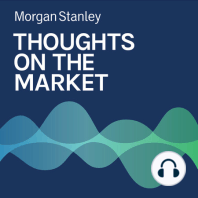3 min listen
Mike Wilson: Preparing for an Icy Winter
ratings:
Length:
4 minutes
Released:
Sep 6, 2022
Format:
Podcast episode
Description
While interest rates have already weighed on asset markets this year and growth continues to slow, the Fed seems poised to continue on its tightening path, meaning investors may need to prepare for part two of our Fire and Ice narrative.-----Transcript-----Welcome to Thoughts on the Market. I'm Mike Wilson, Chief Investment Officer and Chief U.S. Equity Strategist for Morgan Stanley. Along with my colleagues, bringing you a variety of perspectives, I'll be talking about the latest trends in the financial marketplace. It's Tuesday, September 6th, at 9 a.m. in New York. So let's get after it. At the risk of stating the obvious, 2022 has been a challenging year for stock investors of all stripes. The Russell 3000 is down approximately 18% year to date, and while growth stocks have underperformed significantly it's been no picnic for value investors either. As far as sectors only energy and utilities are up this year, and just 24% of all stocks in the Russell 3000 are in positive territory. To put that into context, in 2008, 48% of the Russell 3000 stocks were up on the year as we entered the month of September and then the bottom dropped out. Suffice it to say, this year has been historically bad for stocks. However, that is not a sufficient reason to be bullish in our view. As bad as has been for stocks, it's been even worse for bonds on a risk adjusted basis. More specifically, 20 year Treasury bonds are now down 24% year to date, and the Barclays AG Index is off by 11%. Finally, commodities have been a mixed bag too, with most commodities down on the year, despite heightened concerns about inflation. For example, the CRB RIND Index, which measures the spot prices of a wide range of commodities, is down 7% year to date. Cash, on the other hand, is no longer trash, especially if one has been able to take advantage of higher front end rates. So what's going on? In our view, asset markets are behaving right in line with the fire and ice narrative we laid out a year ago. In short, after ignoring the warning signs from inflation last year and thinking the Fed would ignore them too, asset markets quickly woke up and discounted the Fed's late but historically hawkish pivot to address the sharp rise in prices. Indeed, very rarely has the Fed tightened policy so quickly. Truth be told, as one of the more hawkish strategists on the street last December, I never would have bet the Fed would be doing multiple 75 basis point hikes this year, but here we are. And remember, don't fight the Fed. While the June low for stocks and bonds was an important one, we've consistently been in the camp that it wasn't the low for the S&P 500 in this bear market. Having said that, we are more confident it was the low for long term treasuries in view of the Fed's aggressive action that has yet to fully play out in the real economy. It may have also been the low for the average stock, given how bad the breadth was at that time and the magnitude of the decline in certain stocks. Our more pessimistic view on the major index is based on analysis that indicates all the 31% de-rating in the forward S&P 500 P/E that occurred from December was due to higher interest rates. We know this because the equity risk premium was flat during this period. Meanwhile, forward earnings estimates for the S&P 500 have come down by only 1.5%, and price earnings ratio's back up 9% from where it was. With interest rates about 25 basis points below the June highs, the equity risk premium has fallen once again to just 280 basis points. This makes little sense in a normal environment, but especially given these significant earnings cuts we think are still to come. With the Fed dashing hopes for a dovish pivot on this policy a few weeks ago, we think asset markets may be entering fire and ice part two. In contrast with part one, this time the decline in stocks will come mostly through a higher equity risk premium and lower earnings rather than higher interest rates. In fact, our earning
Released:
Sep 6, 2022
Format:
Podcast episode
Titles in the series (100)
Mike Wilson: Are U.S. Economic Indicators Flashing Yellow? by Thoughts on the Market
